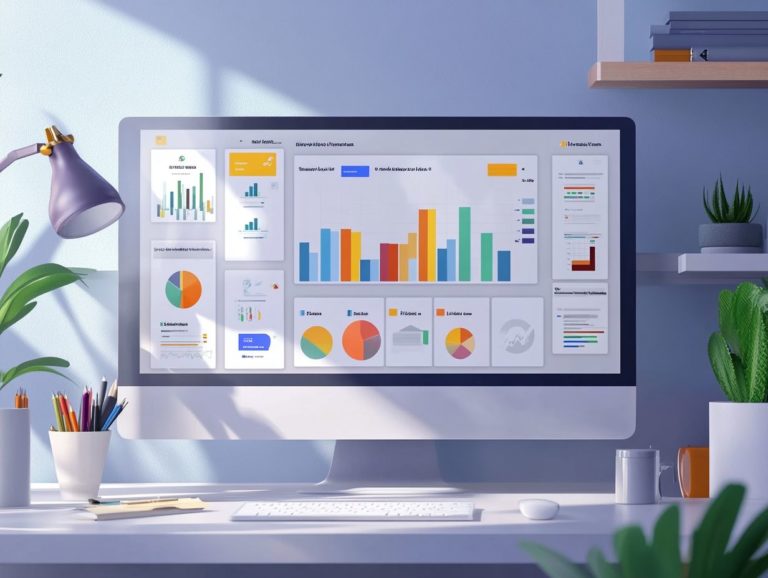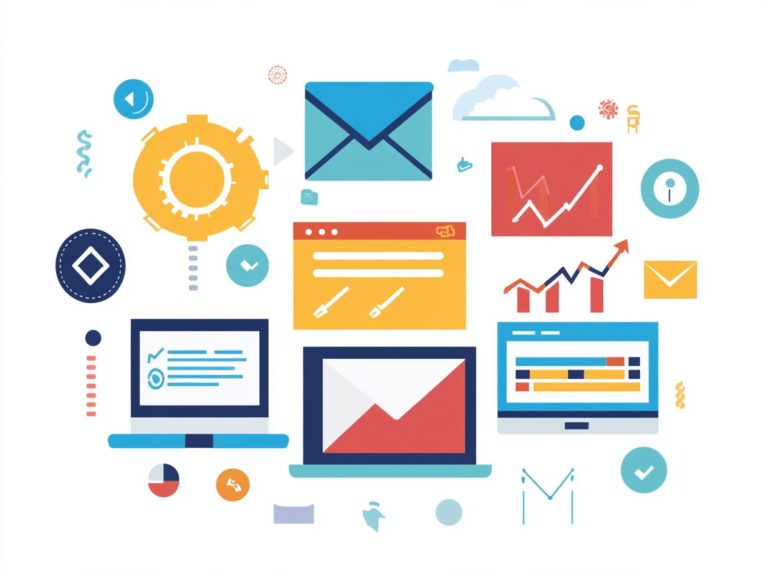How to Use Email for Customer Feedback
Let's Set Up Your Lead Generation Strategy
Fill out the form below, and our team will get in touch with you to create a tailored solution for your business.
Customer feedback is a key component of a successful business strategy. It provides valuable insights that can enhance improvements, elevate customer satisfaction, and strengthen customer relationships, ultimately driving business growth.
This article unveils the benefits of using email to gather feedback. We will showcase effective strategies and best practices for crafting compelling requests that lead to high-quality feedback responses.
You will also learn about the various types of feedback you can seek, how to analyze and act on responses, and discover tips to boost your response rates.
Get ready to gain powerful tools that will transform customer insights into exciting enhancements, paving the way for positive experiences and increased customer loyalty.
Contents
- Key Takeaways:
- The Importance of Customer Feedback
- Using Email for Gathering Feedback
- Let's Set Up Your Lead Generation Strategy
- Types of Feedback to Ask for via Email
- Analyzing and Utilizing Feedback
- Let's Set Up Your Lead Generation Strategy
- Tips for Improving Response Rates
- Frequently Asked Questions
- What is the purpose of using email for customer feedback?
- How can I effectively use email for customer feedback, and what are the best feedback strategies?
- What type of questions should I ask in customer feedback emails to gather actionable feedback?
- How often should I send customer feedback emails while maintaining customer relationships?
- Let's Set Up Your Lead Generation Strategy
Key Takeaways:
- Customer feedback is crucial for business success. It helps identify areas for improvement and build customer loyalty.
- Email is a convenient and effective way to gather feedback, allowing for easy data collection and analysis.
- To receive useful feedback, be clear and concise in your email requests. Ask specific questions and offer incentives for responses.

The Importance of Customer Feedback
Customer feedback drives success by directly shaping customer experience and enhancing customer satisfaction. It fosters trust and boosts customer engagement. By effectively gathering and analyzing these insights, you can identify areas for improvement and refine your service delivery.
This ongoing feedback loop strengthens customer relationships and cultivates loyalty, essential for sustainable growth and creating significant sales opportunities. Actionable feedback provides valuable insights to guide product optimization and inform your marketing strategies.
Why Customer Feedback Matters for Businesses
Understanding the importance of customer feedback in today s competitive landscape is essential. It shapes your strategies around consumer insights and feedback. This significance arises from the useful information you can act on from customer opinions, driving improvements in your products and services while building customer loyalty.
By actively listening to your customers, you can identify pain points and areas needing improvement. This enables you to make informed strategic decisions. These insights become powerful tools, helping you tailor offerings to meet customer expectations and launch new products or service enhancements.
Ultimately, fostering a robust feedback mechanism cultivates a symbiotic relationship where customers feel valued and heard, reinforcing their commitment to your brand.
Using Email for Gathering Feedback
Email is an effective means to gather feedback, allowing you to engage with customers and collect valuable insights through personalized emails and feedback requests.
By crafting personalized emails for specific customer segments, you can significantly boost response rates. This makes it easier to request feedback on your products, services, or overall customer experience.
Thoughtfully designed email surveys yield actionable feedback that informs your business strategies, drives continuous improvement, and enhances customer satisfaction.
Start listening to your customers today for a stronger tomorrow!
Benefits of Email for Feedback Collection

Using email to collect feedback is incredibly beneficial. It’s affordable and keeps your audience engaged.
Let's Set Up Your Lead Generation Strategy
Fill out the form below, and our team will get in touch with you to create a tailored solution for your business.
One major advantage is targeted outreach. You can tailor your requests to specific demographics, gathering insights that truly matter and improving the overall customer experience.
Flexibility in timing is crucial too. Respondents can participate at their convenience, increasing the chances of receiving thoughtful responses. For example, a well-crafted survey sent via email can achieve a remarkable 30% response rate far superior to traditional methods.
You can quickly analyze survey responses using various software tools, allowing for quick adaptations to your strategies. This fosters a more responsive approach to customer feedback. These features make email a formidable tool for enhancing service quality and elevating customer satisfaction.
Best Practices for Email Feedback Requests
Implementing best practices can significantly enhance both the quality and quantity of responses.
Focus on clear and engaging communication elements to create an interactive dialogue with your audience. Start with a subject line that grabs attention; something like “We Value Your Thoughts!” will grab your readers’ attention instantly!
Next, don t underestimate the power of a clear call to action (CTA). Instead of vague prompts, opt for specific requests like “We want to hear from you! Click here to share your thoughts!”
Timing matters! Send your request right after a purchase or interaction to make it more relevant, increasing the likelihood of receiving constructive customer input. A well-structured email might include personalized greetings, a brief explanation of why the feedback matters, and a straightforward link to the feedback form, all designed to motivate participation.
Types of Feedback to Ask for via Email
Identifying the various types of feedback to request through email allows you to tailor your approach, significantly enhancing the quality of customer insights you receive.
Understanding what specific information you’re seeking lets you craft requests that resonate more deeply with your audience. This ultimately leads to more valuable and actionable feedback, enhancing your customer interactions.
Examples of Different Types of Feedback
You can gather a variety of feedback effectively through emails, such as customer satisfaction scores, insights on product features, and evaluations of the overall service experience.
These metrics offer invaluable insights as you refine your strategies, especially during product launches. For instance, using surveys to assess customer satisfaction can pinpoint areas needing improvement, while gathering feedback on specific product features helps identify enhancements that resonate with your audience.
Evaluating general service experiences can reveal strengths and weaknesses in your customer interactions.
By meticulously analyzing these feedback methods, you can tailor your offerings to engage customers more effectively and foster loyalty. This approach leads to improved customer experiences and heightened satisfaction, ultimately fostering a robust customer loyalty program.
Analyzing and Utilizing Feedback

Analyzing and leveraging feedback is essential if you re looking to elevate customer experiences and fuel service improvements. This step not only shows your commitment to quality but also enables informed decisions that resonate with your audience.
Let's Set Up Your Lead Generation Strategy
Fill out the form below, and our team will get in touch with you to create a tailored solution for your business.
Embracing feedback can transform your approach and lead to meaningful enhancements in your offerings.
How to Interpret and Act on Feedback
Interpreting and acting on feedback is essential if you aim to elevate your customer interactions, improve support services, and facilitate effective service recovery. Understanding service recovery simply means addressing issues effectively to win back customer trust.
By carefully looking at the details in feedback, you can distinguish between actionable insights that drive meaningful changes and general opinions that may not require immediate attention. It’s crucial to adopt a structured approach to this process; consider categorizing feedback into themes to help your teams identify recurring issues or suggestions.
Taking timely actions based on feedback fosters stronger relationships with customers, builds trust, and enhances your feedback strategies. This proactive stance can lead to greater customer satisfaction and loyalty.
Tips for Improving Response Rates
Enhancing response rates for feedback requests is essential for your business, as it directly impacts customer engagement and overall satisfaction. This process allows you to gather invaluable insights and elevate customer engagement to new heights.
Increasing the Likelihood of Receiving Feedback
Enhancing the likelihood of receiving valuable feedback from customers is possible with thoughtful strategies and polished communication.
Streamlining the feedback process makes it much easier for customers to voice their opinions through user-friendly surveys and feedback channels. Employ user-friendly surveys, direct prompts on your website, or leverage social media to boost participation and gather customer insights.
Personalizing your requests to reflect individual customer experiences showcases your genuine interest and inspires more detailed insights. Offering incentives like discounts or exclusive content in exchange for feedback can motivate customers to share their thoughts.
These techniques, along with actively promoting open channels for suggestions and utilizing platforms like Trustpilot, Yelp, and Google, create an environment where feedback is not just welcomed but eagerly anticipated.
Frequently Asked Questions

What is the purpose of using email for customer feedback?
The purpose of using email for customer feedback is to gather valuable insights about their experiences with your product or service. This ensures you can adapt your offerings based on their feedback and enhance their overall buyer experience.
How can I effectively use email for customer feedback, and what are the best feedback strategies?
To effectively use email for customer feedback, send personalized surveys, use clear and concise language, and provide incentives for participation. Ensure the email is visually appealing and easy to navigate.
What type of questions should I ask in customer feedback emails to gather actionable feedback?
Ask relevant questions that can provide actionable insights. These can include queries about customer satisfaction, product features, and suggestions for improvement.
How often should I send customer feedback emails while maintaining customer relationships?
The frequency of sending customer feedback emails varies by business and customer base. Generally, send them after customers have had a chance to experience your product or service, avoiding too frequent contact to prevent overwhelming them.
Let's Set Up Your Lead Generation Strategy
Fill out the form below, and our team will get in touch with you to create a tailored solution for your business.
How should I handle negative feedback received through email to improve service recovery?
Negative feedback can be valuable for business improvement, so handle it with care. Acknowledge the customer’s concerns, apologize if necessary, and offer solutions or ask for further feedback. Following up to address the issue effectively is also important.
How Can I Use Customer Feedback Gathered Through Email to Improve My Business?
To improve your business using customer feedback from emails, look at the feedback you received. Identify frequent comments or problems and make necessary changes to your product or service.
Be sure to share these improvements with your customers. You can also use positive feedback as testimonials on platforms like Trustpilot, Yelp, and Google to attract potential customers.






